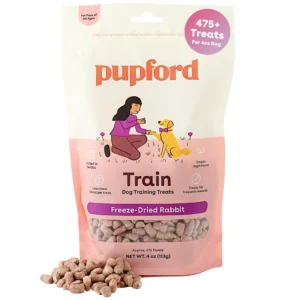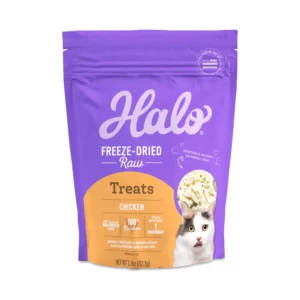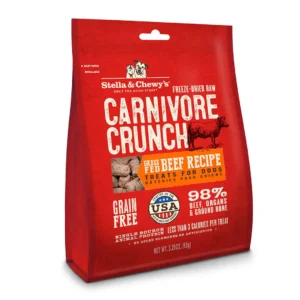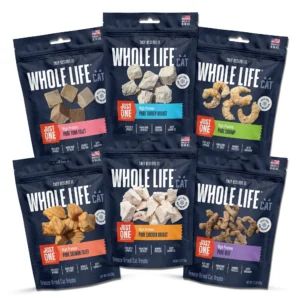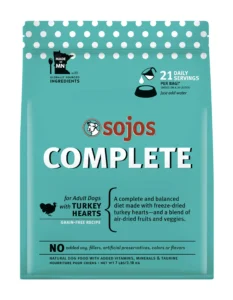
Best Freeze-Dried Dog Treats for Weight Management in 2025
Quick Answer: The Weight Management Winners
Looking for the absolute best freeze-dried treats to help your dog shed those extra pounds? Here’s the deal: Pupford Freeze-Dried Training Treats take the crown with less than 1 calorie per treat, while Stella & Chewy’s Carnivore Crunch delivers just 3 calories per nugget with incredible flavor variety. These aren’t just treats—they’re your secret weapons in the battle against canine obesity.
The magic lies in freeze-drying technology, which removes moisture while preserving nutrients and flavor… meaning your pup gets maximum taste satisfaction with minimal caloric impact. Think of it like concentrated happiness in treat form.
The Complete Guide to Freeze-Dried Treats for Chunky Pups
Why Freeze-Dried Treats Are Game-Changers for Weight Loss
You know that guilty feeling when your dog gives you those soul-melting puppy eyes, and you cave… again? Yeah, we’ve all been there. But here’s the thing—traditional treats can pack anywhere from 20 to 50 calories each. Do the math on that during a training session, and suddenly you’ve fed your dog an entire extra meal without realizing it.
Freeze-dried treats flip this script entirely. The process involves freezing the treat at extremely low temperatures, then using a vacuum to remove ice crystals directly—no heat required. What you’re left with is essentially the concentrated essence of the original ingredient, minus about 98% of the moisture content.
This isn’t just some fancy food science mumbo-jumbo, either. The removal of water means you’re getting pure nutrition without the bulk. A single freeze-dried chicken breast treat might weigh a fraction of a fresh equivalent, but it delivers the same protein punch. It’s like having a nutritional concentrate that your dog thinks is candy.
The Science Behind Weight Management Treats
Let’s get nerdy for a second (but in a fun way, I promise). Successful weight management in dogs relies on three fundamental principles:
Caloric Deficit: Your dog needs to burn more calories than they consume. Simple math, really, but execution? That’s where things get tricky.
Protein Preservation: During weight loss, you want to maintain muscle mass while shedding fat. High-protein, low-calorie treats help achieve this balance without turning your pup into a hangry furball.
Satiety Factors: Some ingredients naturally help dogs feel fuller longer. Fiber-rich options and high-protein treats trigger satiety hormones that say “I’m good, thanks” instead of “MOAR FOOD PLS.”
The best freeze-dried treats leverage all three principles. They’re calorie-conscious by design, protein-rich by nature, and often include ingredients that promote fullness.
Top 5 Freeze-Dried Treats That Actually Work
1.Pupford Freeze-Dried Training Treats: The Calorie Miser’s Dream
I’ll be honest—when I first heard “less than 1 calorie per treat,” I was skeptical. How could something that tiny satisfy a dog’s treat expectations? Turns out, I was thinking about this all wrong.
These little nuggets are made primarily from chicken and pea protein, creating what I like to call “flavor bombs” that pack serious taste into minimal calories. Each bag contains hundreds of treats, which means you can reward your dog constantly during training without the caloric guilt.
The genius lies in their size. They’re small enough that your dog gets the psychological reward of receiving a treat, but the caloric impact is essentially negligible. It’s like giving your dog a high-five in edible form.
Pros:
- Practically zero caloric impact
- Perfect for intensive training sessions
- Hundreds of treats per bag
- Clean ingredient list
Cons:
- Might not satisfy dogs who expect “substantial” treats
- Size could be too small for large breed dogs
- Some dogs might need multiple pieces to feel rewarded
2. Halo Liv-A-Littles: The Pure Protein Powerhouse
Eight calories per treat might sound like a lot compared to Pupford’s offering, but consider this: most traditional treats clock in at 25-50 calories each. Halo’s treats deliver substantial satisfaction while keeping caloric damage minimal.
What I love about these is their versatility. You can use them as high-value training rewards, crush them over food as a meal topper, or even use them as “puzzle treats” hidden around the house for mental stimulation. The freeze-dried chicken maintains its texture and flavor remarkably well, creating that satisfying “crunch” dogs seem to crave.
The grain-free formula means you’re not dealing with unnecessary fillers or potential allergens. It’s just chicken, doing what chicken does best—being delicious and nutritious.
Best for: Dogs who need substantial treats but are on calorie restriction Avoid if: Your dog has chicken allergies (obviously)
3.Stella & Chewy’s Carnivore Crunch: The Flavor Variety Champion
Three calories per nugget hits that sweet spot between satisfaction and restriction. But here’s what really sets these apart—the flavor variety is absolutely amazing. Turkey, beef, chicken, duck… it’s like a carnivore’s buffet in treat form.
This variety isn’t just about keeping things interesting (though your dog will definitely appreciate that). Different protein sources provide different amino acid profiles, and rotating between them can help prevent food sensitivities from developing.
The texture is spot-on too. They’re crunchy enough to provide that satisfying “munch” sound that makes both dogs and owners happy, but not so hard that they’ll break teeth or cause jaw fatigue.
Pro tip: Buy multiple flavors and rotate them throughout the week. Your dog will think they’re getting different treats, when really they’re just getting nutritional variety.
4.Whole Life Just One Ingredient: The Minimalist’s Choice
Sometimes simple is better. These treats live up to their name—literally one ingredient, whether that’s beef liver, chicken, salmon, or pumpkin. At about 6 calories per gram, they offer excellent portion control flexibility.
The single-ingredient approach is brilliant for dogs with food sensitivities or owners who want complete transparency about what their pet is eating. No mystery ingredients, no “natural flavors,” no preservatives—just the thing itself, freeze-dried.
Beef liver varieties are particularly interesting because liver is incredibly nutrient-dense. We’re talking vitamin A, B vitamins, iron, and other essential nutrients that support overall health while keeping calories in check.
Important note: These can be quite hard, so they might not be suitable for senior dogs or those with dental issues. You can soften them with a tiny bit of water if needed.
5.Sojos Natural: The Raw Diet Compatible Option
For dogs already on raw diets (or owners considering the transition), Sojos offers freeze-dried treats that align with raw feeding principles. Made from raw turkey and other meats without grains, gluten, or chemicals, they’re as close to “natural” as you can get in treat form.
The calorie content varies by protein source, but they generally fall into the low-calorie category. What’s interesting is how these treats can serve as a bridge food—introducing dogs to raw proteins without the commitment or complexity of a full raw diet.
Some pieces can be greasier than others (it’s the nature of using real meat), but most dogs see this as a feature, not a bug. The extra fat content provides satiety benefits, helping dogs feel satisfied with smaller quantities.
Understanding Your Dog’s Weight Management Needs
Not all chunky dogs are created equal. A slightly overweight Golden Retriever has different needs than a dog carrying extra weight, and your treat strategy should reflect this reality.
For Mildly Overweight Dogs (5-10% over ideal weight): Focus on portion control rather than dramatic calorie restriction. Low-calorie treats like Pupford’s work perfectly here—you can maintain normal treat-giving frequency while reducing caloric impact.
For Significantly Overweight Dogs (15%+ over ideal weight): More aggressive calorie management is needed. Consider treats as training tools only, not daily indulgences. Stella & Chewy’s 3-calorie nuggets provide satisfaction without derailing weight loss efforts.
For Dogs with Specific Health Conditions: Always consult your vet, but generally, single-ingredient options like Whole Life treats offer the most control over exactly what your dog consumes.
The Hidden Benefits You Didn’t Expect
Freeze-dried treats offer advantages beyond just weight management that might surprise you:
Dental Health: The crunchy texture helps scrape plaque from teeth naturally. It’s not a replacement for proper dental care, but every little bit helps.
Convenience: These treats are shelf-stable and don’t require refrigeration. Perfect for training sessions in the park or long car rides.
Emergency Rations: In a pinch, high-quality freeze-dried treats can supplement meals. They’re nutritionally dense enough to sustain dogs temporarily if you run out of regular food.
Travel-Friendly: No mess, no spoilage concerns, and they take up minimal space in luggage or hiking packs.
Expert Tips for Maximum Weight Loss Success
The 10% Rule (And Why It Matters)
Here’s something most dog owners don’t know: treats should never exceed 10% of your dog’s daily caloric intake. Sounds simple, right? Until you realize that many dog owners have no idea how many calories their dog should be eating in the first place.
A 50-pound dog typically needs around 1,000-1,200 calories per day (depending on activity level). That means treats should max out at 100-120 calories daily. With traditional treats at 25-50 calories each, you can see how quickly things add up.
With freeze-dried low-calorie options, you have more flexibility. Pupford treats at less than 1 calorie each? You could literally give your dog 100 of them and still be within guidelines. (Though please don’t actually do this—your dog will think they’ve won the lottery and might not eat their actual food.)
Timing Is Everything
When you give treats matters almost as much as which treats you choose. Strategic timing can amplify weight loss benefits:
Pre-meal treats: A few high-protein treats 10-15 minutes before mealtime can trigger early satiety signals, causing your dog to eat less of their regular food.
Post-exercise rewards: Protein-rich treats after exercise help with muscle recovery and metabolism boosting.
Training session treats: Use the lowest-calorie options during extended training sessions to avoid caloric overload.
Bedtime treats: A small, satisfying treat before bed can prevent midnight begging and help establish routine.
The Water Trick
Here’s a neat hack I discovered accidentally: lightly moistening freeze-dried treats with water creates a completely different eating experience. The treats soften slightly and develop more intense flavors, making them seem more substantial without adding calories.
Some dogs prefer this texture, especially older dogs or those with dental sensitivity. Plus, it adds a tiny bit of hydration to their day—never a bad thing.
Making Treats Work Harder
Instead of just handing over treats, make your dog work for them. This mental stimulation burns additional calories while making each treat feel more rewarding:
Puzzle feeders: Load freeze-dried treats into puzzle toys Hide and seek: Scatter tiny treats around the yard for “hunting” Training rewards: Only give treats for completed commands or tricks Slow dispensing: Use treat-dispensing balls that release rewards gradually
Reading Your Dog’s Hunger Cues
Dogs are masters of manipulation when it comes to food. Those sad eyes? The dramatic sighs? The way they somehow appear in the kitchen every time you open a package? Yeah, that’s mostly learned behavior, not actual hunger.
Learning to distinguish between genuine hunger and attention-seeking behavior is crucial for weight management success. True hunger signs include:
- Searching for dropped food more actively than usual
- Increased interest in their regular meals
- Less selective eating (willing to eat foods they normally ignore)
Attention-seeking behaviors include:
- Performing “tricks” without being asked (especially near treat storage)
- Excessive drooling when treats appear
- Dramatic “starving dog” performances during family meals
Common Mistakes That Sabotage Weight Loss
The “But It’s Healthy” Trap
Just because a treat is labeled “natural,” “organic,” or “grain-free” doesn’t mean it’s low-calorie. Some of the most expensive, premium treats are caloric bombs that can completely derail weight loss efforts.
I’ve seen dog owners switch from generic training treats to “premium organic sweet potato chews” thinking they’re making a healthier choice, when in reality they’ve tripled their dog’s treat calories. Always check the caloric content regardless of marketing claims.
The Family Conspiracy
This one’s real talk time. Weight management fails most often due to what I call “family sabotage.” It usually goes like this: one family member commits to the diet plan, while others continue sneaking treats “because they feel bad for the dog.”
Everyone in the household needs to be on the same page. Consider creating a “treat log” where family members track what treats they give and when. It sounds excessive, but it’s eye-opening to see how quickly treats accumulate throughout the day.
The Exercise Compensation Error
“We went on a long walk, so they earned extra treats.” Sound familiar? This mindset completely undermines weight loss efforts. Exercise burns calories, but not nearly as many as most people think.
A 50-pound dog burns roughly 12-15 calories during a 30-minute walk. One traditional dog biscuit contains 25-50 calories. See the problem? The treat “reward” often contains more calories than the exercise burned.
The Plateau Panic
After initial success, weight loss often plateaus. This is normal! Many owners panic and either drastically reduce treats (making dogs miserable) or give up entirely. Instead, consider:
- Switching protein sources in treats
- Adding more mental stimulation activities
- Consulting your vet about adjusting base food portions
- Increasing exercise duration rather than intensity
The Weekend Warriors
Some families maintain strict diets during weekdays but relax rules on weekends. While this might work for humans, dogs don’t understand weekend treat amnesty. Consistency is crucial for canine weight management.
If you want to provide special weekend treats, plan for them by slightly reducing weekday portions or increasing weekend activity levels.
Frequently Asked Questions
How many freeze-dried treats can I give my dog per day?
This depends on your dog’s size, weight loss goals, and the specific treats you’re using. As a general rule, treats shouldn’t exceed 10% of daily calories. For a 50-pound dog (approximately 1,100 daily calories), that means about 110 calories worth of treats maximum. With low-calorie freeze-dried options like Pupford (less than 1 calorie each), you could theoretically give 100+ treats, though I’d recommend spreading them throughout training sessions rather than giving them all at once.
Can freeze-dried treats replace part of my dog’s regular food?
High-quality, single-ingredient freeze-dried treats can occasionally supplement meals, but they shouldn’t regularly replace balanced dog food. If you’re using treats as meal toppers or supplements, reduce the regular food portion accordingly and consult your vet about nutritional balance. Think of treats as seasoning, not the main course.
Are freeze-dried treats safe for puppies on weight management?
Puppy weight management is tricky and should always involve veterinary guidance. While freeze-dried treats are generally safe for puppies over 12 weeks old, growing dogs have different nutritional needs than adult dogs losing weight. Focus on high-protein, low-calorie options and ensure treats don’t interfere with proper puppy food intake.
How long do freeze-dried treats stay fresh after opening?
Most freeze-dried treats remain fresh for 2-4 weeks after opening if stored in airtight containers. They’ll lose crunchiness before they spoil, so if treats seem soft or chewy, they’re past their prime but likely still safe. For maximum freshness, store in cool, dry places and consider transferring to airtight containers immediately after opening.
Can I make my own freeze-dried treats at home?
Home freeze-drying requires specialized equipment that costs $2,000+, making it impractical for most dog owners. However, you can create similar low-calorie treats using a regular dehydrator or even an oven on very low heat. Thinly sliced chicken breast, sweet potato, or beef liver can be dehydrated into healthy, low-calorie treats.
My dog doesn’t seem satisfied with low-calorie treats. What can I do?
Try these strategies: Use treats during training or puzzle games rather than as free handouts (mental stimulation increases satisfaction), rotate between different protein flavors to maintain interest, slightly moisten treats with water to enhance flavor and texture, or combine low-calorie treats with praise and petting to increase overall reward value.
Are there any health conditions that make freeze-dried treats unsuitable?
Dogs with severe kidney disease might need to limit protein intake, making high-protein freeze-dried treats problematic. Dogs with diabetes require careful carbohydrate monitoring, so stick to single-ingredient meat treats. Always consult your vet if your dog has chronic health conditions, takes medications, or has food allergies.
How quickly should I expect to see weight loss results?
Safe weight loss for dogs is 1-2% of body weight per week. For a 60-pound dog, that’s about 0.6-1.2 pounds weekly. You should see noticeable changes within 2-3 weeks of consistent diet management. If weight loss is faster than 2% weekly or slower than expected after 4-6 weeks, consult your veterinarian.
Can I use freeze-dried treats for multiple dogs with different dietary needs?
Absolutely! Single-ingredient freeze-dried treats work well in multi-dog households because you can adjust portions per dog. Use tiny pieces for the dog on weight management and larger portions for dogs maintaining weight. Just ensure each dog gets treats appropriate for their individual needs.
What’s the difference between freeze-dried and dehydrated treats?
Freeze-drying removes moisture through sublimation (ice directly to vapor), preserving more nutrients and creating a crispier texture. Dehydration uses heat to remove moisture, which can destroy some heat-sensitive vitamins but often results in chewier textures. For weight management, both can work well—focus on calorie content rather than processing method.
Do freeze-dried treats help with food allergies?
Single-ingredient freeze-dried treats are excellent for dogs with food allergies because you know exactly what you’re feeding. They’re also useful for elimination diets when trying to identify allergens. However, always introduce new proteins gradually and watch for reactions.
How do I transition from high-calorie to low-calorie treats?
Make the switch gradually over 5-7 days. Start by mixing your current treats with freeze-dried options, gradually increasing the proportion of low-calorie treats. This prevents your dog from feeling “cheated” and helps them adjust to new textures and flavors. Pairing the transition with increased training or puzzle activities can make the new treats feel more rewarding.
Bottom Line: Your Dog’s Weight Loss Success Story Starts Here
Listen, I get it. Watching your chunky pup enjoy life while you worry about their health creates this weird internal conflict. You want them happy, but you also want them healthy… and sometimes those goals feel mutually exclusive.
Here’s the truth: they’re not.
The best freeze-dried treats for weight management in 2025 prove that you can have both. Pupford Freeze-Dried Training Treats remain the gold standard for ultra-low-calorie options, while Stella & Chewy’s Carnivore Crunch delivers satisfaction without caloric devastation. Halo Liv-A-Littles bridges the gap for dogs who need more substantial rewards, and Whole Life Just One Ingredient offers transparency that sensitive dogs require.
But here’s what really matters: consistency beats perfection every single time. You don’t need to be a perfect dog parent who never gives an extra treat or never sneaks them a piece of chicken from dinner. You just need to be mindful, strategic, and committed to the long game.
Your dog’s weight loss journey isn’t just about the number on the scale—it’s about adding years to their life and life to their years. Every smart treat choice, every training session, every decision to choose a 3-calorie nugget over a 30-calorie biscuit… it all adds up.
And honestly? Most dogs end up happier during weight management because they’re getting more attention, more training, more mental stimulation. They’re not just getting fed—they’re getting engaged with.
So start with one bag of freeze-dried treats. Pick the option that fits your dog’s needs and your budget. Use them strategically, consistently, and watch as your pup transforms into the healthier, more energetic version of themselves you know they can be.
Their future self will thank you for it. And their vet will be pretty impressed too.
